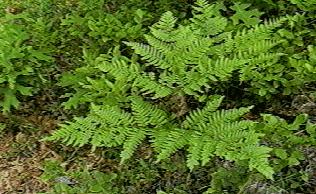



 |
|
 |
|
Bracken Fern
Pteridium aquilinum
First posted February 1, 2004 Last updated February 14, 2004
![]()

The bracken fern is one of the most common ferns of the Redwood Forest community, and is one of the only ferns that has a world-wide distribution. It can tolerate a wide variety of habitats, from dry, open slopes to moist, shaded, sheltered areas. It grows 1 to 4 feet tall, and can be identified by the branching form of the pinnae (leaves). Most of the ferns will have all the pinnae growing from one point at the base, but the bracken fern has them branching off in layers up the stems. You can see the spores maturing in the small encasings called sporangia on the under sides of the leaves in later spring and early summer. They turn brown during the summer.
![]()
Bracken fern has many interesting qualities. It is rarely found in forests older than 200 years, which are considered only "middle aged' redwood forests. When damaged, the fern fronds release hydrogen cyanide gas. Despite production of numerous bitter-tasting compounds that interfere with insect growth, a relatively large number of insects eat bracken ferns.
"Often considered a pest or nuisance species by ranchers and wildlife managers, bracken fern was considered so valuable during the Middle Ages that it was used as a medium of monetary exchange. Bracken ferns were employed as roofing material, used as a source of fuel for a quick, hot fire, acted as a source of potash for the pre-1860 soap and glass industries, and were used for manufacturing bleach. Rhizome extracts dyed wool yellow and tanned leathers. In Wales, bracken fern is still utilized as winter livestock bedding since it is warmer and easier to handle than straw. Native Americans peeled the starchy fiber of the bracken fern rhizomes into flour, while in Japan, confections are created from the rhizome starch. Raw rhizomes were consumed by Native Americans as a remedy for bronchitis, and a powdered form prescribed against parasitic worms. Additionally, the bracken fern is commercially grown for use as a food and herbal remedy in Japan, Canada, the United States, Siberia, China, and Brazil. Both fronds and rhizomes of bracken ferns have been used in brewing beer, and the starch sometimes substitutes for arrowroot. Picked in the spring, fiddleheads are consumed fresh or preserved by salting, pickling, or sun drying."
(Written by Cynthia D. Kelly, Thomas J. Fellers and Michael W. Davidson - National High Magnetic Field Laboratory, 1800 East Paul Dirac Dr., The Florida State University, Tallahassee, Florida, 32310